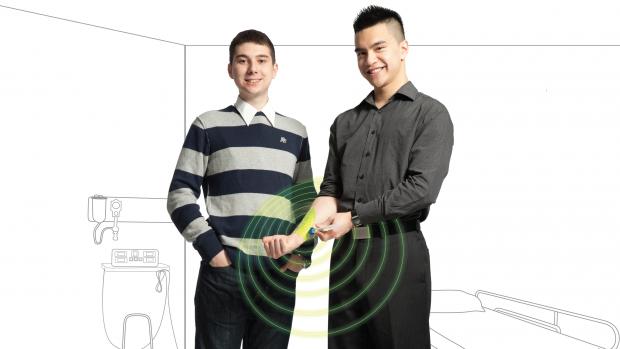Inno/Vention Student Idea Competition: Behind the Scenes

“It’s just been a really good day, but I’m also glad that I can stop staying up all night,” smiled Joe Landolina. The freshman, who is pursuing chemical and biological engineering bachelor’s and master’s degrees at Polytechnic Institute of New York, is one half of the duo that comprises Suneris Technologies, the team that took first-place honors on April 7 at the 2011 Time Warner Cable Inno/Vention Student Innovation and Idea Competition. He and partner Kenny Mai spent sleepless nights working on their proposal for Medi-gel, an organic, gelatinous covering for wounds and lacerations, an invention that may one day replace Band-Aids as we know them today.
Such improvements go to the heart of the competition, which challenges students to find ways to benefit the world through technology. Based on the number of idea proposals submitted, which increased by nearly 100 percent in 2011, the challenge is popular among students. Ideas submitted ranged from the fantastical (greening human skin for a kind of photosynthesis) to the practical (SIM cards that allow cell phone holders to complete transactions with their mobile devices). The individuals and teams who made it to the finals, however, focused their efforts on ideas and products that could be implemented in the near future. Other than that shared characteristic, the proposals varied in their aim and audience. Filip Mleckicki, for instance, proposed Shred Something, a social networking application geared towards enthusiasts of action sports, while Ismail Patik suggested a magnet-based technology for buffering buildings against earthquakes.
From the Drawing Board to the Board of Investors
[GALLERY:5189|left]
Winning concepts form just half of the i2e — innovation, invention, and entrepreneurship — philosophy that defines NYU-Poly; competitors also had to demonstrate how their ideas could succeed in the marketplace. They had help with their efforts via workshops held earlier in the competition when students learned about business plans, which address, among other topics, how a company will market itself and its products, as well as the timeline by which a company will reach profit goals. Those who made it to the finals then had to present their plans and ideas to judges drawn from the science, technology, legal, and business fields. Winning teams and individuals received cash prizes underwritten by Time Warner Cable, as well as support in developing commercial strategies and prototypes.
The process was reminiscent of the steps any new start-up might take as it seeks to secure funding, and Phil Won, senior director of the Product Management Group at Time Warner Cable and a judge at the competition, believed it provided students with invaluable insight into real world business dealings. “I can’t think of any business that doesn’t rely on technology to some extent,” he said. “To be able to leverage technical expertise in a business environment is very important. If you can’t present your ideas successfully, you’re not going to be successful.”
John DiMatteo, who heads up the intellectual property department at Wilkie Farr & Gallagher LLP and who also judged the competition this year, stressed that all the competitors were “winners just for entering and going through the process.” Reminding participants that the marketplace is based on competition, he suggested that events such as Inno/Vention are good preparation for life after school. “Inspiring innovation among young engineers is a wonderful thing,” said DiMatteo. “Hopefully, they won’t lose that innovative spirit once they’re out in the real world.”
Inspiring Young Engineers
DiMatteo judged the university competitors, but his comments might as well have been directed at the high school entrants included in the competition for the first time this year. Eighty teams from around the country submitted applications, with those that made it into the finals represented by area high schools. Said Sarah Cacciabaudo from Smithtown High School, “It was a great experience, and I really like how we were able to tour the campus and go into certain labs and actually see engineering being done.”
For Eileen Rowe, science director at Smithtown High School, Inno/Vention “allows students to see that other people are involved in the same type of work they are.” She chaperoned the Smithtown team, which came in second place for its proposal: a double-axis solar tracker that follows the sun throughout the day, drawing energy for electronics and other small household items. Rowe also wished to recognize Dr. Joanne Figueirdo, the team’s mentor, for her efforts in leading the team to success.
Although NYU-Poly students had no official mentors, participants did receive inspiration from the Institute’s professors. Shred Something, which was awarded second place at the university level, first began as a project Mlekicki fulfilled for MG 9753, Exploring the Creative Process, a course introduced by Professor Anne-Laure Fayard of NYU-Poly’s Department of Technology Management last fall. Zony Smart Sim, Zhile Zhao’s submission, was prompted when Professor Matthew Campisi of the Institute’s Department of Electrical and Computer Engineering handed out flyers about the competition to students. Speaking to the important connections drawn between the classroom and marketplace, NYU-Poly Provost Dianne Rekow ended the competition’s award ceremony by remarking, “Inno/Vention is an example of something that we value very highly: the opportunity to apply classroom learning to hands-on projects and to take ideas into the real world.”
For a complete list of winners, please visit the competition page.




